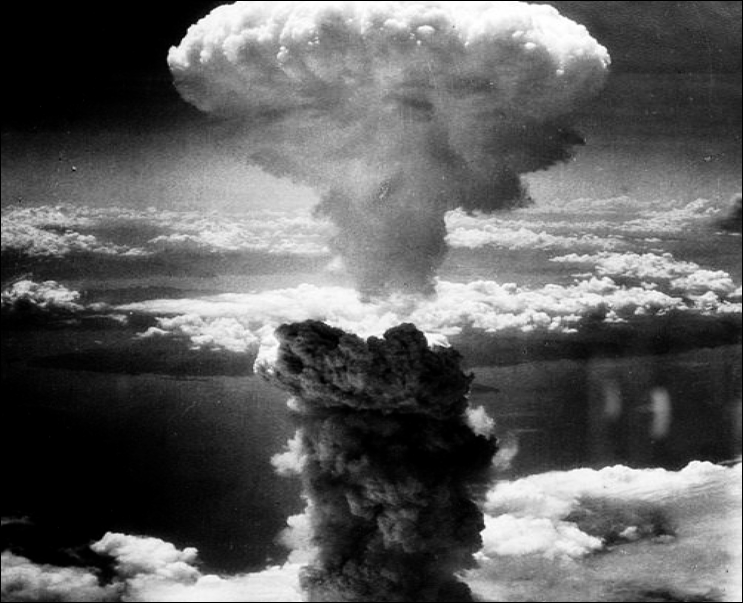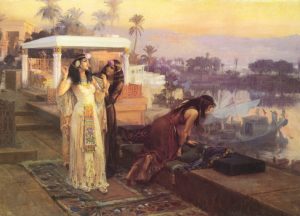Winner of the Spring 2017 StMU History Media Awards for
Best Article in the Category of “World History”
“We knew the world would not be the same. A few people laughed, a few people cried, most people were silent. I remembered the line from the Hindu scripture the Bhagavad Gita. Vishnu is trying to persuade the prince that he should do his duty and to impress him takes on his multiarmed form and says, ‘Now, I am become Death, the destroyer of worlds.’ I suppose we all thought that one way or another.”1
- J. Robert Oppenheimer, The Decision to Drop the Bomb

Throughout the history of human warfare, conflict has pushed humans to innovate–to build ever larger and deadlier weapons, each more lethal than the last. However, it was not until World War II and the invention of the atomic bomb that humanity has been able to kill on such a massive and efficient scale. Case in point, in the final days of World War II, the United States carried out one of the most chilling instances of mass murder in the history of humanity: the bombing of the Japanese cities of Hiroshima and Nagasaki. These attacks ultimately killed an estimated 294,000 people, the majority of whom were noncombatants.2 In comparison, the Japanese attack on Pearl Harbor killed just 2,408 American citizens, although this is largely due to the focused Japanese attack on military targets, namely the Pacific fleet and U.S. airfields.3 To give a more modern frame of comparison, the terrorist attacks against the World Trade Center and Pentagon, considered to be by far the worst terrorist attacks against the United States, claimed the lives of 2,974 American citizens.4
In the spring of 1945, World War II was entering its final stages. The Allies had already achieved victory in Europe with Germany’s surrender on May 7th, but the conflict on the Pacific front was still going strong. In the years leading up to the two World Wars, Japan’s victories against two larger countries–China in the Sino-Japanese War (1894–1895) and Russia in the Russo-Japanese War (1904–1905)–combined with other factors, forged a strong sense of Japanese nationalism, militarism, and cultural superiority. This fervent nationalism, integrated with the Japanese warrior ethic known as bushido, made the prospect of a Japanese surrender unlikely, even as the Allies began to position for an invasion of the Japanese mainland.5

Concurrently, since as early as 1942, President Franklin Delano Roosevelt had been secretly sponsoring and funding The Manhattan Project, the code name used for the $2 billion U.S. effort to develop a nuclear weapon before the Germans. A team of top physicists led by Dr. Julius Robert Oppenheimer were assigned to this project, a task so secret that not even individuals as important as then Vice President Harry S. Truman was aware of it. Shortly after Roosevelt’s untimely death and Truman’s subsequent inauguration to the presidency in April 1945, he was informed that the Manhattan Project was approaching success–that a nuclear weapon would be feasible in just four short months.6
Faced with the prospect of a costly and deadly invasion of Japan, Truman and his advisors were faced with a difficult choice: utilize this new atomic weapon or try to defeat Japan through conventional means. In late July, the United States issued the Postdam Declaration, a statement which gave Japan the choice between unconditional surrender or total annihilation. When this declaration went ignored, President Truman authorized the use of the atomic bomb.7

On the morning of August 6, 1945, Colonel Paul Tibbets piloted the Enola Gay over the city of Hiroshima, where his crew dropped an atomic bomb code-named “Little Boy.” Upwards of 70,000 people died instantly in the blast. Additionally, 48,000 buildings were destroyed and another 22,000 were damaged, leaving only 6,000 buildings untouched. Three days later, on August 9th, a second bomb was dropped onto Nagasaki, killing another 36,000 people. In total, an estimated 295,000 were killed in the blasts or from complications from the resulting nuclear fallout.8
Emperor Hirohito ordered the surrender of Japan on August 10, 1945. On August 15th, radios across Japan broadcasted Hirohito’s words as he read the declaration of surrender to the Japanese people, thus ending World War II. The bombs’ effectiveness in forcing the Japanese to surrender is still subject of popular debate among historians to this day, given that the Russian invasion of Japan-controlled Manchuria occurred at the same time of Nagasaki, both of which likely impacted Japan’s will to continue fighting.9 Even so, while the political and military effects of these blasts may be debated, none can contest their tragedy and devastation.

- Jason Pontin, “Oppenheimer’s Ghost,” MIT Technology Review, October 15, 2007. https://www.technologyreview.com/s/408835/oppenheimers-ghost/. ↵
- Dennis W. Cheek, “Hiroshima and Nagasaki,” in Encyclopedia of Science, Technology, and Ethics, edited by Carl Mitcham, Vol. 2, Detroit: Macmillan Reference USA, 2005. Gale Virtual Reference Library (accessed February 6, 2017), 923. ↵
- Sonia Benson, Daniel E. Brannen, Jr., and Rebecca Valentine, “Pearl Harbor Attack,” in UXL Encyclopedia of U.S. History, Vol. 6, Detroit: UXL, 2009. Gale Virtual Reference Library (accessed February 6, 2017), 1208. ↵
- Stefan M. Brooks, “September 11 Attacks,” in The Encyclopedia of Middle East Wars: The United States in the Persian Gulf, Afghanistan, and Iraq Conflicts, edited by Spencer C. Tucker, Vol. 3, Santa Barbara, CA: ABC-CLIO, 2010. Gale Virtual Reference Library (accessed February 6, 2017), 1096. ↵
- “The United States Drops the Atomic Bomb on Hiroshima and Nagasaki,” in Global Events: Milestone Events Throughout History, edited by Jennifer Stock, Vol. 2, Asia and Oceania, Farmington Hills, MI: Gale, 2014. Gale Virtual Reference Library (accessed February 5, 2017), 361. ↵
- “An Overview of the Atomic Bombings of Hiroshima and Nagasaki,” in The Atomic Bombings of Hiroshima and Nagasaki, edited by Sylvia Engdahl, Perspectives on Modern World History, Detroit: Greenhaven Press, 2011. Gale Virtual Reference Library (accessed February 6, 2017), 13-14. ↵
- “An Overview of the Atomic Bombings of Hiroshima and Nagasaki,” in The Atomic Bombings of Hiroshima and Nagasaki, edited by Sylvia Engdahl, Perspectives on Modern World History, Detroit: Greenhaven Press, 2011. Gale Virtual Reference Library (accessed February 6, 2017), 14-15. ↵
- Dennis W. Cheek, “Hiroshima and Nagasaki,” in Encyclopedia of Science, Technology, and Ethics, edited by Carl Mitcham, Vol. 2, Detroit: Macmillan Reference USA, 2005. Gale Virtual Reference Library (accessed February 6, 2017), 923. ↵
- “The United States Drops the Atomic Bomb on Hiroshima and Nagasaki,” in Global Events: Milestone Events Throughout History, edited by Jennifer Stock, Vol. 2, Asia and Oceania, Farmington Hills, MI: Gale, 2014. Gale Virtual Reference Library (accessed February 5, 2017), 361. ↵



152 comments
Annissa Noblejas
The use of nuclear weapons against the Japanese in WW2 embodies the debate of ‘just because you can, does it mean you should?’. The bombings certainly achieved it’s political goal of gaining Japan’s surrender and by defact, ended WW2. But the targets were not military personnel, they were civilian cities. I’m not sure the end justified the means within this objective.
Rosa Castillo
When we learn about the bomb attacks of Hiroshima and Nagasaki in school, we are often taught the cookie-cutter version of the story. I think this article brings a great reality to a horrific attack from the United States. In times of threat the nature of warfare is controversial. I think the content of the article could have gone more in depth about why the United States resorted to a grave use of warfare such as the atomic bombs and how that was ultimately the best choice for the security of the country.
Daniela Martinez
This article was very informative and a great read overall. I think that war is never the option regardless of the case, but even now threats like this still exist today, as seen with North Korea. I think that the U.S Bombings of Hiroshima and Nagasaki serve to teach us and remind of the fatal effects of such threats. Regardless of the situation, this tragic event in history should continue to teach us that innocent lives are at cost if we don’t work to understand our differences and that the consequences of war will have long-lasting effects that can be avoided.
Damian Jennings
This weapon of mass pulverization perpetually changed the world, when America dropped the bombs on Hiroshima and Nagasaki the world was in awe to see such a weapon of destruction in action. I trust we utilized this deadly weapon with the wrong intention. This bomb was very destructive to innocent individuals and families, those that were not immediately killed during impact would later die due to the high levels of radiation.
Luis Magana
The bombings of Hiroshima and Nagasaki was such a significant event in WWII. These bombings killed so many people it should never be forgotten. So many of the people killed were innocent and they still suffered the consequences of war. President Truman was the one who authorized the bombings, but who knows if things would of turned out different if they would of decided to invade the heartland of Japan instead of total annihilation. People preferred to choose the cost of human life.
Jose Fernandez
I always like to be as informed as possible about the events of World War II and this article really helped. The author does a great job summarizing the most important aspects of the bombings. It is sad that most of the victims were civilians that had nothing to do with the conflicts. I personally think that bombing two cities was way too extreme.
Noah Bolhuis
This is one of the most famous, or infamous, events in world history. As this article said, there was two options, invade the heartland of Japan or total annihilation. The question to which option was better at the time comes down to which was more costly to human life. There are many people that believe that the bombing of these cities would have been less costly that a full invasion, and I believe that is true as well. However, the action that truly saved the most lives was the Japanese emperor’s unconditional surrender, because the bombings would have continued until there was no more Japan.
Hailey Rodriguez
I had learned about these horrible events in history class in high school. I more prominently remember learning about Hiroshima and the extremity of the damage from this event. I was not aware that the fatality number was so high compared to Pearl Harbor. Before reading this article, I would have thought that Pearl Harbor and these two bombings were of an equivalent amount of damage and deaths.
Maxx Arizmendi
War: it still happens around the world each day as time goes on. I remember reading about WWII and how President Truman authorized the bombs to be dropped, and I realized that in a way he is a mass murderer. This is because the bombings killed about almost 300,000 people and it is sad that they were many innocent lives. Then again, this was during a time of war, and the US had to use any means necessary to end the war. I found this article to be an interesting read.
Jabnel Ibarra
This article was very well structured. However, when explaining the context of the war that led to the decision to make use of nuclear weaponry, the term Bushido was used to describe the Japanese warrior mentality that made Japanese soldiers particularly dangerous. Defining the term in the context of your article can provide readers with a deeper understanding as to why the use of atomic bombs was a preferable alternative to both the Japanese and American loss of life that would have resulted if the United States had instead invaded the mainland as originally planned.